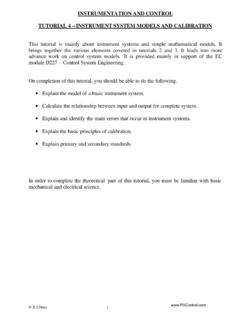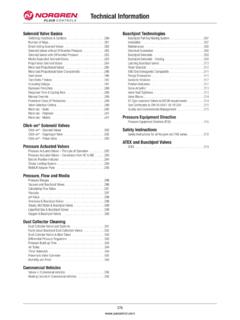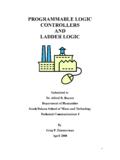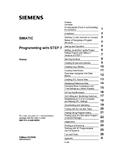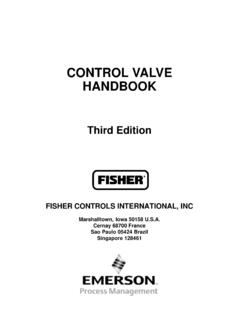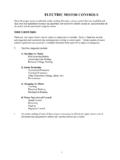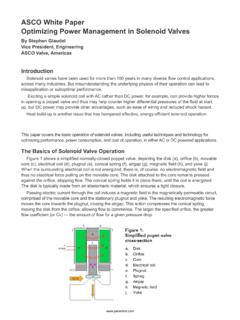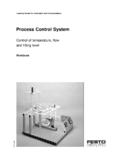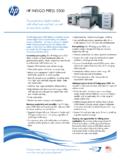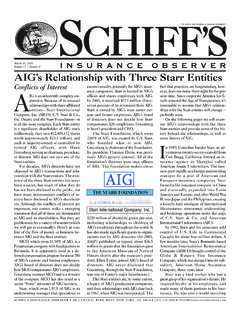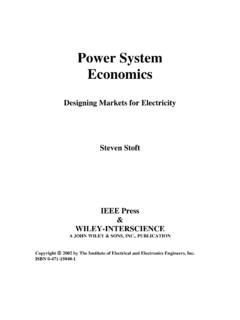Transcription of Instrumentation & Control - Process Control and ...
1 Instrumentation & ControlProcess Control FundamentalsTable of ContentsFundamentals of Controlii 2006 1 Performance Objective .. 1 The Importance of Process Control .. 1 Learning 1 The Importance of Process 2 Process Control .. 2 Reduce Variability .. 2 Increase Efficiency .. 3 Ensure Safety .. 3 Control Theory Basics .. 4 Learning 4 The Control Loop .. 5 Three Tasks ..5 Process Control Terms ..6 Process ..6 Measured Variables, Process Variables, and Manipulated .. Disturbance ..8 Control and Automatic Control ..9 Closed and Open Control Loops ..10 Components of Control Loops and ISA Symbology .. 11 Learning 11 Control Loop Equipment and Technology .. 12 Primary 12 Transducers and 13 Transmitters .. 13 Signals .. 14 Pneumatic Signals .. 14 Analog 14 Digital Signals .. 15 Indicators .. 15 Recorders .. 16 Controllers .. 16 Correcting Elements/Final Control Elements .. of ContentsiiiFundamentals of Control 2006 Symbology ..19 Symbols.
2 20 Pumps .. 21 Piping and Connections .. 22 Identification 23 Tag 23 ISA Symbology Review .. 26 Controller Algorithms and Tuning ..27 Learning Algorithms ..28 Discrete Controllers ..28 Multistep Controllers ..29 Why controllers need tuning? ..31 Gain ..31 Proportional Mode ..33 Proportional Gain ..33 Proportional Band ..33 Limits of Proportional action ..34 Determining the Controller Action- Closed 35 .Integral Mode .. 37 Integral Action .. 37 Open Loop Analysis .. 37 Closed Loop Analysis .. 38 Reset Windup .. 39 Summary .. 40 Derivative Mode .. 41 Derivative Action .. 41 Rate Summary .. 44 Process Control Control Loops ..47 Feedback Control ..47 Examples Of Single Control Control Loops ..49 Flow Control Loops ..49 Level Control Loops ..50 Temperature Control Loops .. of ContentsFundamentals of Control iv 2006 / Advanced Control Loops ..52 Multivariable Loops ..52 Feedforward Control ..53 Feedforward plus Feedback ..54 Cascade Control .. 55 Batch Control .
3 56 Ratio Control .. 56 Selective 57 Fuzzy Control .. of Controlv 2006 in Process industries refers to the regulation of all aspects of the Process . Precise Control of level, temperature, pressure and flow is important in many Process applications. This module introduces you tocontrol in Process industries, explains why Control is important, and identifies different ways in which precise Control is following five sections are included in this module: The importance of Process Control Control theory basics Components of Control loops and ISA symbology Controller algorithms and tuning Process Control systemsAs you proceed through the module, answer the questions in the activities column on the right side of each page. Also, note the application boxes (double-bordered boxes) located throughout the module. Application boxes provide key information about how you may use your baseline knowledge in the field. When you see the workbook exercise graphic at the bottom of a page, go to the workbook to complete the designated exercise before moving on in the module.
4 Workbook exercises help you measure your progress toward meeting each section s learning OBJECTIVEA fter completing this module, you will be able to determine needed Control loop components in specific Process Control of Control1 2006 Importance of Process ControlRefining, combining, handling, and otherwise manipulating fluids to profitably produce end products can be a precise, demanding, and potentially hazardous changes in a Process can have a large impacton the end result. Variations in proportions, temperature, flow, turbulence, and many other factors must be carefully and consistently controlled to produce the desired end product with a minimum of raw materials and energy. Process Control technology is the tool that enables manufacturers to keep their operations running within specified limits and to set more precise limits to maximize profitability, ensure quality and safety. LEARNING OBJECTIVESA fter completing this section, you will be able to: Define Process Define Process Control Describe the importance of Process Control in terms of variability, efficiency, and safetyNote: To answer the activity questions the Hand Tool (H) should be Importance of Process ControlActivities2 Fundamentals of Control 2006 Importance of Process ControlPROCESSP rocess as used in the terms Process Control and Process industry,refers to the methods of changing or refining raw materials to create end products.
5 The raw materials, which either pass through or remain in a liquid, gaseous, or slurry (a mix of solids and liquids) state during the Process , are transferred, measured, mixed, heated or cooled, filtered, stored, or handled in some other way to produce the end industries include the chemical industry, the oil and gasindustry, the food and beverage industry, the pharmaceutical industry,the water treatment industry, and the power industry. Process CONTROLP rocess controlrefers to the methods that are used to Control processvariables when manufacturing a product. For example, factors such as the proportion of one ingredient to another, the temperature of the materials, how well the ingredients are mixed, and the pressure under which the materials are held can significantly impact the quality of an end product. Manufacturers Control the production Process for three reasons: Reduce variability Increase efficiency Ensure safetyReduce VariabilityProcess Control can reduce variability in the end product, which ensures a consistently high-quality product.
6 Manufacturers can also save money by reducing variability. For example, in a gasoline blending Process , as many as 12 or more different componentsmay be blended to make a specific grade of gasoline. If the refinery does not have precise Control over the flow of the separatecomponents, the gasoline may get too much of the high-octanecomponents. As a result, customers would receive a higher grade and more expensive gasoline than they paid for, and the refinerywould lose money. The opposite situation would be customers receiving a lower grade at a higher Process is defined as the changing or refining of raw materials that pass through or remain in aliquid, gaseous, or slurry state to 2. Which of these industries are examples of the Process industry?Select all options that apply. PharmaceuticalSatelliteOil and GasCementPowerto create end Importance of Process ControlThe Importance of Process ControlFundamentals of Control3 2006 variability can also save money by reducing the need for product padding to meet required product specifications.
7 Paddingrefers to the Process of making a product of higher-quality than itneeds to be to meet specifications. When there is variability in the end product ( , when Process Control is poor), manufacturers are forced to pad the product to ensure that specifications are met, which adds to the cost. With accurate, dependable Process Control , thesetpoint(desired or optimal point) can be moved closer to the actual product specification and thus save the manufacturer EfficiencySome processes need to be maintained at a specific point to maximize efficiency. For example, a Control point might be the temperature atwhich a chemical reaction takes place. Accurate Control of temperatureensures Process efficiency. Manufacturers save money by minimizing the resources required to produce the end SafetyA run-away Process , such as an out-of- Control nuclear or chemicalreaction, may result if manufacturers do not maintain precise controlof all of the processg variables. The consequences of a run-awayprocess can be Process Control may also be required to ensure safety.
8 Forexample, maintaining proper boiler pressure by controlling the inflowof air used in combustion and the outflow of exhaust gasesis crucialin preventing boiler implosions that can clearly threaten the safety What are the main reasons for COMPLETE WORKBOOK EXERCISE - THE IMPORTANCE OF Process CONTROLPV limit to ensure qualityPV SetpointHigh VariabilityPV limit to ensure qualityPV SetpointLow Variabilitymanufacturers to Control a Process ?Select all options that variabilityEnsure safetyReduce costsIncrease efficiencyIncrease of Control4 2006 Theory BasicsThis section presents some of the basic concepts of Control and provides a foundation from which to understand more complex Control processes and algorithms later described in this module. Common terms and concepts relating to Process Control are defined in this section. LEARNING OBJECTIVESA fter completing this section, you will be able to: Define Control loop Describe the three tasks necessary for Process Control to occur: Measure Compare Adjust Define the following terms: Process variable Setpoint Manipulated variable Measured variable Error Offset Load disturbance Control algorithm List at least five Process variables that are commonly controlled in Process measurement industries At a high level, differentiate the following types of Control : Manual versus automatic feedback Control Closed-loop versus open-loop controlNote: To answer the activity questions the Hand Tool (H) should be Theory BasicsActivities5 Fundamentals of Control 2006 Control LoopImagine you are sitting in a cabin in front of a small fire on a cold winter evening.
9 You feel uncomfortably cold, so you throw another log on the fire. Thisis an example of acontrol loop. In thecontrol loop, a variable (temperature) fell below the setpoint (your comfort level), and you took action to bring the Process back into the desired condition by adding fuel to the fire. The Control loop will now remain static until the temperature again rises above or falls below your comfort TASKSC ontrol loops in the Process Control industry work in the same way, requiring three tasks to occur: Measurement Comparison AdjustmentIn Figure , a level transmitter (LT) measures the level in the tank and transmits a signal associated with the level reading to a controller (LIC). The controller compares the reading to a predetermined value, in this case, the maximum tank level established by the plant operator, and finds that the values are equal. The controller then sends a signal to the device that can bring the tank level back to a lower level a valve at the bottom of the tank.
10 The valve opens to let some liquid out of the different instruments and devices may or may not be used in Control loops ( , transmitters, sensors, controllers, valves, pumps), but the three tasks of measurement, comparison, and adjustment are always present. A Simple Control LoopLTLICM aximumlevel1. The three tasks associated with any Control loop are measurement,comparison, and adjustment. Is this statement true or false? Theory BasicsFundamentals of Control6 2006 Control TermsAs in any field, Process Control has its own set of common terms that you should be familiar with and that you will use when talking about Control VARIABLEA Process variable is a condition of the Process fluid (a liquid or gas) that can change the manufacturing Process in some way. In the example of you sitting by the fire, the Process variable was temperature. In the example of the tank in Figure , the Process variable is level. Common Process variables include: Pressure Flow Level Temperature Density Ph (acidity or alkalinity) Liquid interface (the relative amounts of different liquids that are combined in a vessel) Mass ConductivitySETPOINTT hesetpointis a value for a Process variable that is desired to bemaintained.
